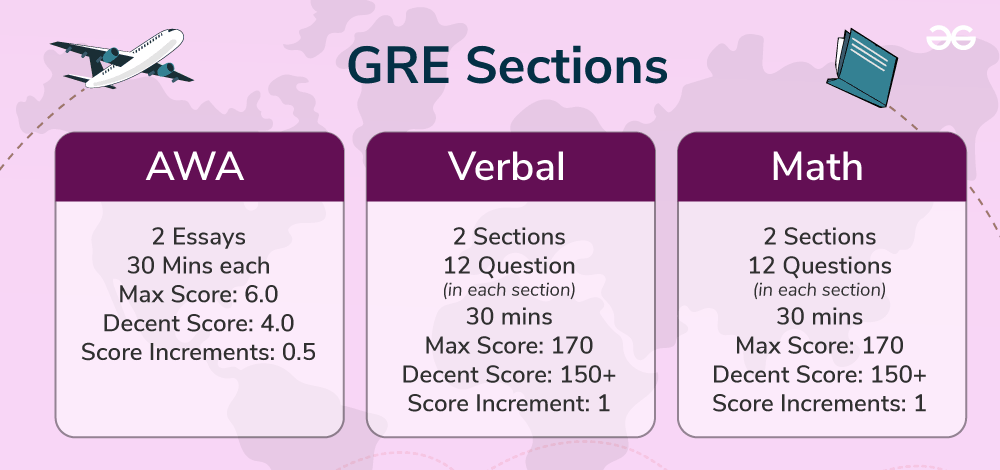The GRE (Graduate Record Examination) is a key requirement for admission to graduate programs worldwide. It evaluates analytical writing, verbal reasoning, and quantitative skills. This blog provides a concise overview of the GRE test format to help you prepare effectively.
What is GRE?
The GRE General Test is an essential step for students aspiring to pursue graduate programs globally. With recent updates, the test is now shorter and more streamlined, taking less than 2 hours compared to the previous 4-hour version.
The exam evaluates three core skills: Verbal Reasoning, Quantitative Reasoning, and Analytical Writing (AWA). While the structure has been modified to save time, the question types and difficulty levels remain unchanged. This means you can continue your preparation as planned without adjusting your strategy.
A brief overview is given below:

Let’s break down the new format in detail, section by section, along with examples for better understanding.
1. Verbal Reasoning
Structure: 2 sections with 24 questions in total.
Time: 41 minutes.
Key Changes: Earlier, this section had 40 questions (20 per section) with 60 minutes allotted. Now, about one-third of the questions have been removed, but the time per question remains consistent.
Question Types:
1. Reading Comprehension: You’ll read a passage (around 200-300 words) and answer questions based on it. For example:
“What is the author’s primary argument in the passage?”
2. Text Completion: Fill in the blanks using context clues. For example:
“The scientist’s theory was considered ____, as it contradicted established principles.” (Options: groundbreaking, dubious, irrelevant).
3. Sentence Equivalence: Choose two words that complete the sentence and have similar meanings. For example:
“Her speech was so ___ that even the critics applauded her eloquence.” (Options: articulate, persuasive, verbose, unclear).
2. Quantitative Reasoning
Structure: 2 sections with 24 questions in total.
Time: 47 minutes.
Key Changes: Like Verbal Reasoning, this section also had 40 questions earlier, completed in 60 minutes. Now, fewer questions make the section more concise.
Question Types:
1. Quantitative Comparison: Compare two quantities and determine the relationship. For example:
Quantity A: 3x + 5; Quantity B: 2x + 10.
2. Multiple Choice: Select one or more correct answers. For example:
“Which of the following numbers are prime? (Options: 2, 4, 5, 6).”
3. Numeric Entry: Solve and type in the answer. For example:
“If a rectangle’s length is 10 and width is 5, what is its area?”
4. Data Interpretation: Analyze charts, graphs, or tables. For example:
“Based on the bar graph, which year saw the highest sales increase?”
To know more about this, check out the video below:
3. Analytical Writing (AWA)
Structure: 2 essays.
Time: 30 minutes.
Key Changes: Previously, there were two tasks: “Analyze an Issue” and “Analyze an Argument,” with 30 minutes each. The “Analyze an Argument” task has been removed, reducing the time for this section by half.
Example Task:
“Some people believe that technological advancements lead to a better quality of life. Others argue that they create more problems than they solve. Discuss your opinion, providing reasons and examples to support your argument.”
You’ll need to take a clear stance, back it with logical reasoning, and use examples. For instance, you might discuss how smartphones have improved communication while also contributing to screen addiction.
Additional Updates
Unscored Section Removed: Earlier, an unscored section with 20 additional questions (from Verbal and Quant) was included for ETS research purposes. This section, which took 30-35 minutes, has been eliminated.
Faster Results: Score reports are now available in 8-10 days instead of 10-15 days.
Free Score Reports: You can send your scores to four universities for free, so shortlist your universities before the test.
A summary of the format is shown below:

FAQs About the New Format
1. Does the scoring system change?
No, the scoring remains the same. Verbal and Quantitative sections are scored out of 170 each (total 340), and the AWA section is scored out of 6.
2. Will university cut-offs change?
No, the difficulty level is unchanged, so cut-offs will likely remain the same.
3. How does the shorter format affect preparation?
It doesn’t! Since the question types and difficulty levels are unchanged, you can continue your current preparation strategy. In fact, if you’ve been preparing for the longer format, you’ll find the shorter version easier to manage.
If you need help with your study abroad journey, including writing SOPs and LORs, we offer personalized guidance through our programs. To learn how to write these documents, do check out our course – Write your Way to Study Abroad. Would like to get it reviewed by us? – then do check out our review program – SOP Review Program.
Good luck with your GRE preparation! Do let us know in the comments below if you have any queries and we would be happy to help 🙂




